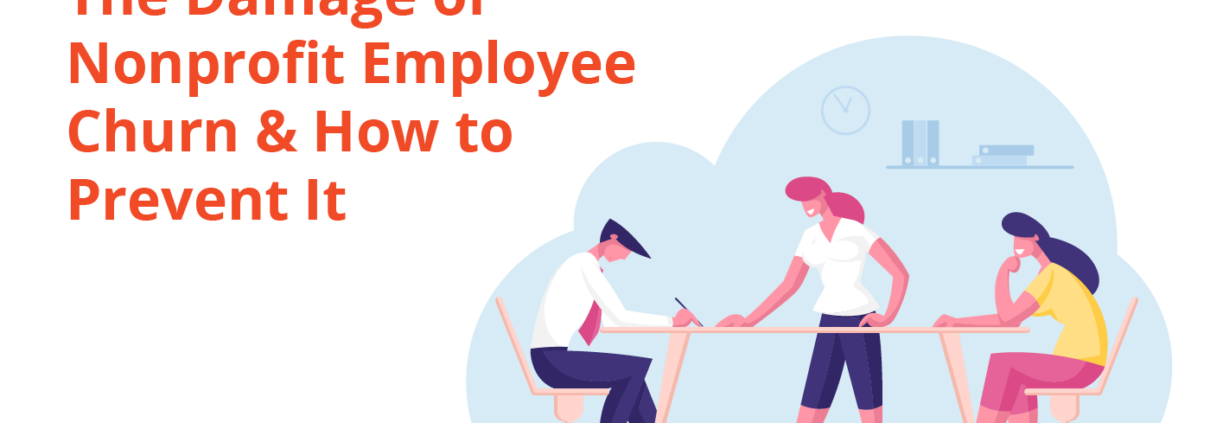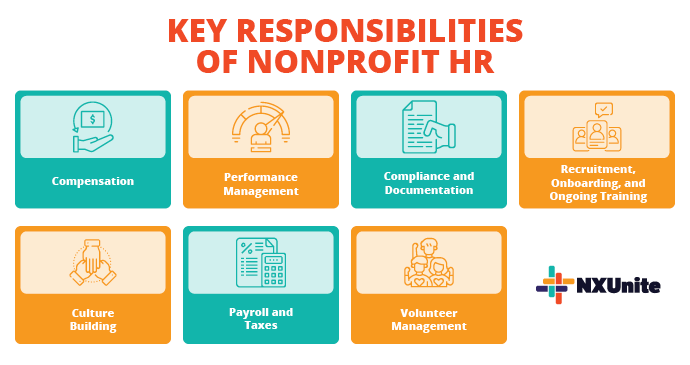The Damage of Nonprofit Employee Churn & How to Prevent It
We’re living in an unusual labor environment—historically low but rising unemployment rates, high inflation, conflicting signs that may or may not point to an impending recession. We’re also seeing highly active labor movements and changing norms following the significant changes brought about by the pandemic and Great Resignation.
Economic anxieties are at a high, so nonprofits naturally have a lot on their minds. When instability is on the radar, most organizations know to strengthen their donor and partner relationships while seeking new ways to diversify their revenue—but look inward, too.
The internal health of an organization is essential for its overall health. Employee retention plays a critically important role.
Let’s take a closer look at the state of employee turnover for nonprofits. Why is it so harmful, and how can you prevent it?
What’s the average nonprofit turnover rate?
The voluntary turnover rate for the nonprofit sector averaged 19% in 2022. It also sits consistently higher than turnover at for-profit businesses.
Historically, 19% turnover is typical, but looking at recent years, we can see some interesting trends. The turnover rate rose to a high of 21% in 2019 but dropped to a low of 14% in 2020 (NonprofitHR). One possible explanation is that the disruptions of the pandemic and the drastically increased need for nonprofit services during that time kept many nonprofit professionals in their jobs.
Since then, the turnover rate has steadily increased to pre-pandemic norms as part of the Great Resignation, with many employees across sectors finding new opportunities. Perhaps your own organization saw the same trends play out at a reduced scale since 2019—a good reminder that while there are many causes of turnover that you can control, there are also external forces that you can’t.
But just because you can’t directly control the forces that drive turnover doesn’t mean you can’t adapt to them! After the disruptions of recent years, nonprofits are already making positive changes.
Specifically, NonprofitHR’s 2022 retention survey found that more nonprofits are now actively tracking employee retention metrics (+4%) and developing formal retention strategies (+13%) than in 2021.
This is great news—it’s impossible to reduce turnover and mitigate its damage without a concrete plan or data to inform it. It would seem that many nonprofits have learned from the lessons of the pandemic years to improve their employee management approach.
So what were those lessons exactly? What are the extended negative impacts of churn?
Why is employee churn so harmful?
There are many reasons why a high turnover rate is harmful to organizations, and they can amplify each other over time if left unchecked, making it increasingly difficult to retain talent. The key risks to consider include:
- Financial cost. First, losing employees is costly. The hiring process to find replacements takes time and resources.
- Opportunity cost. Time spent rehiring is time that could otherwise go towards revenue-generating activities. Not to mention, it takes time for new hires to begin reaching the same productivity as more senior team members who departed. For example, The Chronicle of Philanthropy estimates that it takes four years for fundraisers to reach full productivity in their roles.
- Cultural and brand damage. Poor retention harms morale, especially if employees feel overworked when empty roles aren’t filled, creating an environment prone to further turnover. These impacts can then spread to harm your organizational brand as a whole, with employees feeling burnt out or disengaged from the mission.
For nonprofits specifically, these risks are heightened. Nonprofits usually operate on tight budgets, making the felt effects of turnover-related financial and opportunity costs especially pronounced. Nonprofits also rely heavily on relationships with donors, sponsors, and funders to sustain their work—relationships built by individual fundraisers or development officers. If these relationships are too siloed, that fundraiser’s departure can make it very difficult to maintain their valuable relationships.
Not to mention, nonprofits need positive public perceptions to continue fundraising and operating their programs effectively. Inconsistent staffing and a reputation as a place where people don’t want to work can cause your community to become disengaged or even lose trust in your nonprofit.
How can you reduce or eliminate these risks?
Enough of the gloomy stuff—what are the steps you can take to prevent these negative impacts from taking root in your organization?
1. Combat turnover.
It seems self-evident, but to avoid the damage of employee turnover, you should actively combat it by prioritizing retention.
Although more nonprofits now actively develop retention strategies, many still don’t. And those that do often haven’t been able to devote much attention to management in the past, so their retention approaches may not be rooted in best practices. What do you need to know about employee retention?
Start by understanding the key elements of an effective strategy. According to Graham-Pelton’s retention guide for nonprofits, these include:
- Benefits and compensation
- Learning and development
- Organizational culture
- Employee engagement
- Career progression
- Recruiting practices
- Management styles
Within these categories fall a wide variety of tactics you can use to engage and retain employees. There’s no one specific arrangement that will work for every nonprofit. Rather, each organization should seek to find the right ratio of tactics that mesh with their cultures, values, and communities. Ensuring that each category is represented will make your overall strategy more effective and well-rounded.
But there are a few big-picture best practices that successful retention strategies share. As you develop your unique configuration of retention tactics, keep these in mind:
- Foster an engaging environment that prioritizes communication and transparency. Explain whyyour organization makes the decisions it does and how employees play roles in its success.
- Create meaningful opportunities for development and progression. Offer actual new skills, responsibilities, and certifications, not just empty new titles or busywork, to help grow new leaders internally.
- Strengthen your recruiting practices. Hiring the right individual for a role will boost the odds of long-term retention. If you feel that your current hiring process is often rushed or not very thorough, give it an update.
- Offer the benefits that you can and that employees want. Nonprofits often aren’t in positions to offer highly competitive salaries and financial benefits, and employees drawn to nonprofit work understand this. But you must still make an effort to stay competitive in whatever ways you can—modest raises, workplace perks, hybrid work flexibility, etc.
- Recognize employee achievements. Make recognition a cornerstone of your culture. Acknowledge valuable employee contributions, express gratitude, and explain to that individual or the whole team why their actions were impactful. A variety of recognition tools and platforms make it easy to build out a sustainable approach.
Building out a retention strategy to reduce turnover in the first place is the single best step you can take to mitigate its damage to your nonprofit.
The best part is that your strategy doesn’t have to be perfect. It should instead be dynamic and adaptive—you won’t know what works best for your unique organization until you try it out, so approach your strategy as a continual learning experience.
2. Reduce knowledge and relationship silos.
With a solid preventative framework in place, we’ll now look at the infrastructural steps you can take to reduce the negative impacts of turnover when it does happen.
The siloing of knowledge and relationships creates undue risks—a departing employee takes their skills and contacts with them. And even if you’re still in touch with a donor after the departure of the gift officer who built that relationship, the relationship may now need to start from square one. To reduce silos, try these best practices:
- Document your internal processes. All kinds of processes and workarounds develop organically over time, but they shouldn’t just live in one employee’s memory—record them in handbooks, manuals, flowcharts, or notes to simplify the work of other (and future) employees.
- Develop concrete reporting protocols, specifically for donations and donor interactions. Clear records of who’s given, when, how much, and all other touchpoints that have occurred are essential for proper stewardship, and they’ll allow your team to seamlessly maintain relationships with donors even if a donor’s primary contact leaves your organization.
- Keep your data clean. Data hygiene ensures your records are actually useful. Meticulously recording donor touchpoints will only be helpful if any gift officer on your team can successfully interpret them, so notes should be recorded in clear, straightforward language. Quantitative data points should also all be entered into your system in a consistent way.
- Standardize your moves management process. Similarly, your gift cultivation and stewardship process should follow a few standardized steps or phases. You likely already have a clear sense of these phases, but is your team referring to them with the same language? Are they designated in your record system? Systematizing this process will ensure that donor relationships can be quickly understood and continued by anyone on your team when needed.
Consider your regulatory context when looking for ways to reduce knowledge and contact silos. For example, grateful patient fundraising programs are subject to more restrictive patient privacy laws that will impact the specific fundraising and data flows that you can use as an organization.
3. Give employees the tools and frameworks to succeed.
Equipping and empowering your employees to drive the greatest impact will go a long way to improve retention. When team members don’t need to waste time and energy with clunky systems and processes, they’ll feel more engaged and able to focus on their real tasks—engaging with donors and constituents, facilitating programs, and keeping your organization running.
And if turnover does occur, you’ll have more efficient, resilient, and intuitive processes in place that reduce its negative impacts.
First, upgrade tech or invest in tech as needed. A modern CRM is a must, as is intuitive fundraising or donation software that truly meets your needs. If you’re feeling locked into a legacy platform that either isn’t offering a great donor experience or creates more problems than it solves for your team, an upgrade is likely a smart move.
And keep in mind that investing in your own ability to drive impact sustainably is an important part of stewarding your mission. Consider whether it’s possible to budget for needed upgrades and new purchases, remembering that sometimes overhead is essential. Or consider conducting a special capacity campaign to fund new investments—always an option if a jolt of capital will take your growth to the next level and you can make a compelling, specific case for support.
Aside from technology, you should also equip your team with the processes, frameworks, and strategies they need to thrive in their roles, especially if your small organization is growing. Ad hoc solutions and approaches may work for a while, but they’re often not scalable. Not only do they become more disorganized over time, but they also lead to worse employee experiences.
Increased organization and efficiency will be key. Moves management and prospect portfolio management systems are great examples of more advanced practices that organizations pick up and adapt as they mature.
Of course, employee churn isn’t 100% avoidable—some employees will always choose to leave for personal reasons or because they’ve found new opportunities.
What your nonprofit can control are the internal forces that drive churn and its potential negative impacts, and it’s not hard to take the first steps. Outline a concrete retention strategy if you haven’t yet. Consider if you’re unnecessarily siloing important knowledge or contacts and whether you’re offering tools and processes that make work easier rather than harder.


